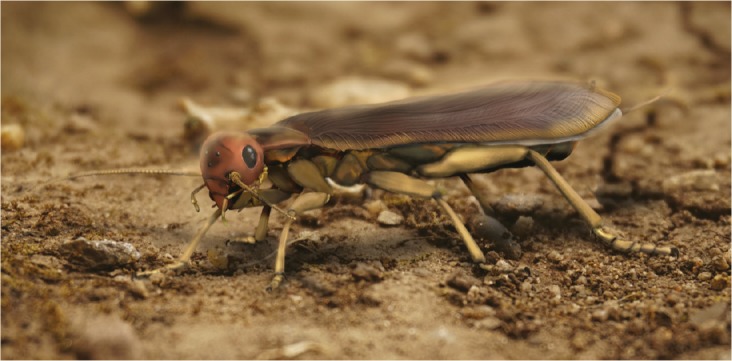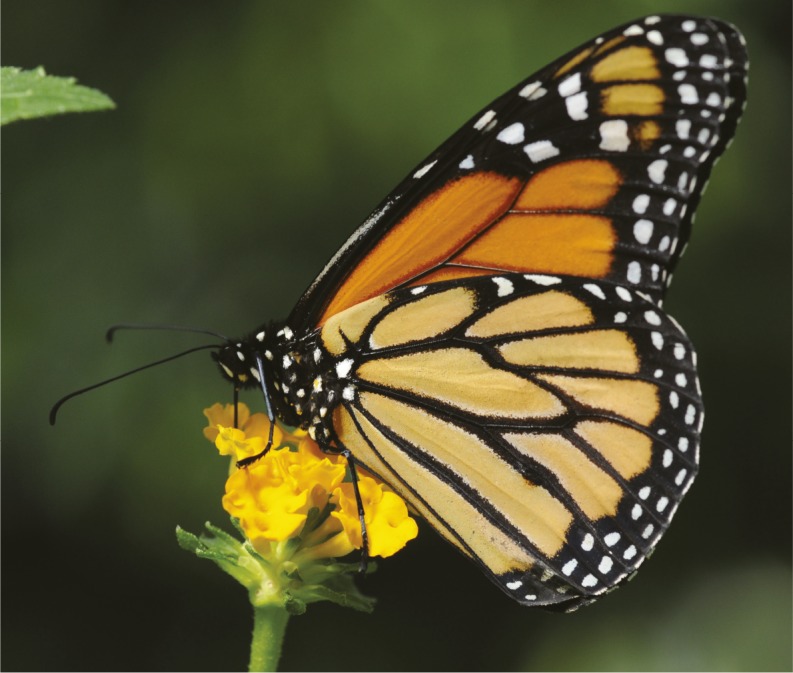Terrestrial ancestors of winged insects

Virtual model of the last common ancestor of Polyneoptera.
Polyneoptera is a lineage of winged insects called Pterygota, which comprises more than 40,000 species. The evolutionary history of Polyneoptera is ambiguous, and whether winged insects evolved in an aquatic or terrestrial environment remains unclear. Benjamin Wipfler et al. (pp. 3024–3029) conducted phylogenomic analyses and reconstructed ancient polyneopteran traits, habitats, and lifestyles. Analysis of 106 existing insect species, including 3,014 protein-coding genes and 112 behavioral, ecological, and morphological characteristics, revealed that polyneopteran insects likely evolved from a ground-dwelling common ancestor that had long antennae and segmented abdominal appendages. The ancestor’s biting mouthparts, located below the head capsule, were similar to those of dragonflies. The authors report that the ancestor also had hardened forewings that would have made flight difficult, resulting in the evolution of triangular hind wings. The findings suggest that wings did not evolve in aquatic environments, as previously speculated. Although several ancestral Pterygota species lived on plants and trees, the common polyneopteran ancestor of modern-day Pterygota eventually returned to life on the ground. The findings also suggest that insects evolved wings for aerial descent, that changes in polyneopteran mouthpart orientation is a frequent evolutionary transition influenced by lifestyle, and that maternal care evolved independently within various insect species, according to the authors. — M.S.
Protein compositions of dinosaur and bird feathers

Anchiornis specimen from Jianchang, western Liaoning, China. The sampling location is marked by a red box.
Analyzing fossilized dinosaur feathers is key to uncovering how feathers evolved into appendages required for avian flight. Flight feathers are typically constructed of β-keratin proteins with a peptide deletion that provides biomechanical hardness and flexibility. Yanhong Pan et al. (pp. 3018–3023) used electron microscopy and chemical analyses to compare flight feathers of a chicken to preserved forelimb feathers of the bird-like dinosaur Anchiornis. Whereas Anchiornis feathers lack the biomechanical properties needed for flight, they exhibit some of the necessary molecular structures. Anchiornis feathers are comprised of both α-keratins and β-keratins, which are also found in reptilian tissue and embryonic bird feathers. Although α-keratins, predominantly found in mammals, dominate the dinosaur feathers, β-keratins are essential proteins in the mature flight feathers of modern birds. Compared with modern bird feathers and fossilized feathers of four other dinosaurs from latter geological ages, Anchiornis feathers also contain lower concentrations of sulfur. The findings suggest that although Anchiornis feathers are not suitable for flight, the presence of β-keratins in the feathers’ molecular structure may signify an intermediate stage in the evolution of avian flight feathers, according to the authors. — M.S.
Genetically modified crops and monarch butterfly decline

Monarch butterfly. Image courtesy of Wikimedia Commons/Thomas Bresson.
Recent decreases in the abundance of monarch butterflies and their food plants, milkweeds, have been linked to genetically modified crops and the associated use of herbicides. However, the role of genetically modified crops in milkweed and monarch declines has not been clear, partly because previous monarch population datasets only extend back to 1993. J. Boyle et al. (pp. 3006–3011) gathered online digitized museum and herbaria records for 1,191 monarch butterfly specimens and 39,510 milkweed specimens collected from 1900 to 2016. Analysis of long-term trends revealed that both monarchs and milkweeds suffered a twofold decline between approximately 1950 and 2016. Moreover, the abundance of the common milkweed, the primary host plant of monarch butterflies, was negatively associated with the number of farms, which declined from 1950 to 2006 as smaller farms consolidated. Taken together, the findings suggest that a decrease in the number of farms may predict common milkweed trends more strongly than herbicide-resistant crops, which were not introduced until 1996. According to the authors, while the findings do not exclude a role for changes in agricultural practices, such as agrochemical use, factors other than genetically modified crops may influence the abundance of monarchs and milkweeds. — J.W.
Protein structure reveals mode of action against western corn rootworm
The Gram-positive soil bacterium Bacillus thuringiensis produces more than 100 insecticidal proteins that target particular pests without harming vertebrates, beneficial insects, or the environment. Genetically modified crops that carry genes for such proteins have reduced pest damage and boosted crop yields, but some insects evolve resistance to B. thuringiensis insecticidal products. Jelena Zaitseva et al. (pp. 2897–2906) applied a method called single isomorphous replacement with anomalous scattering to the recently discovered Gram-negative insecticidal protein dubbed GNIP1Aa and solved the protein’s crystal structure at 2.5-Å resolution. The authors found that the protein comprises two structurally distinct domains with unique properties that appear to act differently from all other known insecticidal proteins. Isolated from a strain of Chromobacterium piscinae, GNIP1Aa exhibits specific toxicity toward western corn rootworm larvae, a major crop pest that takes a heavy economic toll. According to the authors, GNIP1Aa might represent a candidate for commercial development that can potentially reduce corn crop damage and help slow the emergence of resistance in the western corn rootworm. — T.J.


